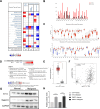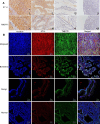ST14 interacts with TMEFF1 and is a predictor of poor prognosis in ovarian cancer
- PMID: 38468232
- PMCID: PMC10929089
- DOI: 10.1186/s12885-024-11958-8
ST14 interacts with TMEFF1 and is a predictor of poor prognosis in ovarian cancer
Abstract
TMEFF1 is a new protein involved in the physiological functions of the central nervous system, and we previously reported TMEFF1 can promote ovarian cancer. ST14 was determined to be involved in the processes of epidermal differentiation, epithelial cell integrity, and vascular endothelial cell migration, etc. The relationship between ST14 and TMEFF1 in the ovary remains unknown. In this study, we detected the expression of ST14 and TMEFF1 in 130 different ovarian cancer tissues through immunohistochemistry. We determined ST14 and TMEFF1 were highly expressed in ovarian cancer, indicating a higher degree of tumor malignancy and a worse prognosis. Tissues significantly expressing ST14 also highly expressed TMEFF1, and the expression of the two proteins was positively correlated. Consistently, immunofluorescence double staining demonstrated the co-localization of ST14 and TMEFF1 in the same region, and immunoprecipitation confirmed the interaction between ST14 and TMEFF1. TMEFF1 expression was also reduced after knocking down ST14 through Western blot. MTT, wound healing and Transwell assays results determined that knockdown of ST14 inhibited proliferation, migration and invasion of ovarian cancer cells in vitro, but the inhibitory effect was restored after adding TMEFF1 exogenous protein. Gene Ontology and Kyoto Encyclopedia of Genes and Genomes pathways analysis showed that ST14 and its related genes were enriched in the processes of epithelial formation, intercellular adhesion, protein localization, and mitosis regulation. We also clarified the kinase, microRNA, and transcription factor target networks and the impact of genetic mutations on prognosis. Overall, high expression of ST14 and TMEFF1 in ovarian cancer predicts higher tumor malignancy and a worse prognosis. ST14 and TMEFF1 co-localize and interact with each other in ovarian cancer. ST14 can regulate TMEFF1 expression to promote proliferation, migration and invasion of ovarian cancer cells. We speculate that the relationship between ST14 and TMEFF1 in ovarian cancer could become a potential target for anti-cancer therapy.
Keywords: Ovarian cancer; Prognostic indicator; Protein interactions; ST14; TMEFF1.
© 2024. The Author(s).
Conflict of interest statement
The authors declare no competing interests.
Figures








Similar articles
-
Interaction between TMEFF1 and AHNAK proteins in ovarian cancer cells: Implications for clinical prognosis.Int Immunopharmacol. 2022 Jun;107:108726. doi: 10.1016/j.intimp.2022.108726. Epub 2022 Mar 23. Int Immunopharmacol. 2022. PMID: 35338959
-
MIR503HG impeded ovarian cancer progression by interacting with SPI1 and preventing TMEFF1 transcription.Aging (Albany NY). 2022 Jun 28;14(13):5390-5405. doi: 10.18632/aging.204147. Epub 2022 Jun 28. Aging (Albany NY). 2022. PMID: 35771155 Free PMC article.
-
Overexpression of TMEFF1 in Endometrial Carcinoma and the Mechanism Underlying its Promotion of Malignant Behavior in Cancer Cells.J Cancer. 2021 Jul 31;12(19):5772-5788. doi: 10.7150/jca.58524. eCollection 2021. J Cancer. 2021. PMID: 34475991 Free PMC article.
-
TMEFF1 overexpression and its mechanism for tumor promotion in ovarian cancer.Cancer Manag Res. 2019 Jan 17;11:839-855. doi: 10.2147/CMAR.S186080. eCollection 2019. Cancer Manag Res. 2019. PMID: 30697076 Free PMC article.
-
Long noncoding RNA MLK7-AS1 promotes ovarian cancer cells progression by modulating miR-375/YAP1 axis.J Exp Clin Cancer Res. 2018 Sep 24;37(1):237. doi: 10.1186/s13046-018-0910-4. J Exp Clin Cancer Res. 2018. Retraction in: J Exp Clin Cancer Res. 2020 Nov 05;39(1):233. doi: 10.1186/s13046-020-01746-0. PMID: 30249278 Free PMC article. Retracted.
Cited by
-
Unveiling diagnostic biomarkers and therapeutic targets in lung adenocarcinoma using bioinformatics and experimental validation.Sci Rep. 2025 Jul 2;15(1):22893. doi: 10.1038/s41598-025-05227-2. Sci Rep. 2025. PMID: 40595823 Free PMC article.
-
Environmental pollutant Di-(2-ethylhexyl) phthalate induces asthenozoospermia: new insights from network toxicology.Mol Divers. 2025 Jun;29(3):2179-2192. doi: 10.1007/s11030-024-10976-9. Epub 2024 Sep 11. Mol Divers. 2025. PMID: 39259422
References
-
- Eib DW, Holling TM, Zwijsen A, Dewulf N, de Groot E, van den Eijnden-van Raaij AJ, Huylebroeck D, Martens GJ. Expression of the follistatin/EGF-containing transmembrane protein M7365 (tomoregulin-1) during mouse development. Mech Dev. 2000;97(1–2):167–71. doi: 10.1016/S0925-4773(00)00426-3. - DOI - PubMed
MeSH terms
Substances
Grants and funding
LinkOut - more resources
Full Text Sources
Medical

